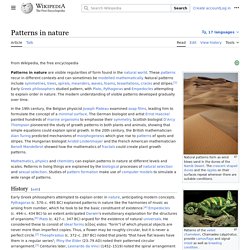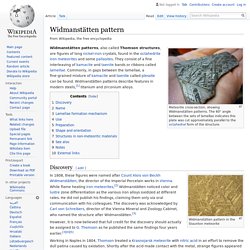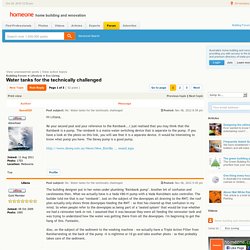

15 Uncanny Examples of the Golden Ratio in Nature. Patterns in nature. Patterns in nature are visible regularities of form found in the natural world.

These patterns recur in different contexts and can sometimes be modelled mathematically. Natural patterns include symmetries, trees, spirals, meanders, waves, foams, tessellations, cracks and stripes.[1] Early Greek philosophers studied pattern, with Plato, Pythagoras and Empedocles attempting to explain order in nature. The modern understanding of visible patterns developed gradually over time. In the 19th century, Belgian physicist Joseph Plateau examined soap films, leading him to formulate the concept of a minimal surface. German biologist and artist Ernst Haeckel painted hundreds of marine organisms to emphasise their symmetry. Mathematics, physics and chemistry can explain patterns in nature at different levels. History[edit] In 1917, D'Arcy Wentworth Thompson (1860–1948) published his book On Growth and Form. Causes[edit] Types of pattern[edit] Symmetry[edit] Widmanstätten pattern.
Meteorite cross-section, showing Widmanstätten patterns.

The 60° angle between the sets of lamellae indicates this plate was cut approximately parallel to the octahedral form of the structure. Discovery[edit] Widmanstätten pattern in the Staunton meteorite However, it is now believed that full credit for the discovery should actually be assigned to G. Thomson as he published the same findings four years earlier.[3][4][5] Name[edit] What is the strongest structure or strongest shape under compression? - Quora. The Case for Round Buildings. There is an undeniable allure to a spherical building.

How can the simplest of shapes replace the complex geometry we see in most modern architecture? It turns out that spheres are not only visually interesting, but incredibly functional. Spheres (and domes) are stronger, use fewer materials, and are more energy efficient than rectangular buildings. Disaster-Proof Architecture: 13 Super-Strong Structures. High-profile earthquakes, tsunamis, floods, hurricanes and other natural disasters have made it more clear than ever that in the face of climate change, stronger buildings able to withstand such events are not just advisable but necessary.

These 13 designs range from fantastical concepts for entire floating cities to real homes that have already proven themselves disaster-proof, and from large-scale billion-dollar projects to low-cost housing solutions for the poor. These typhoon-powered wind turbines could power Japan for 50 years straight. A Japanese engineer has invented the world's first typhoon-powered wind turbine - an electricity generator designed to harness the energy packed inside tropical cyclones.

Engineer Atsushi Shimizu says an array of his generators could power Japan for up to 50 years from a single typhoon - and considering six such storms have hit the country this year, we're talking about a lot of potential energy. "Japan actually has a lot more wind power than it does solar power - it's just not utilised," Shimizu told Junko Ogura and Jenni Marsh at CNN. "Japan has the potential to be a superpower of wind. " According to Shimizu, who founded green energy company Challenergy in 2013, the wind turbines Japan imports from Europe are not suitable for the country's specific climate. The innovators: hexagonal homes could give first-time buyers a hive of their own.
Ancient Greeks originally theorised that the elegant shape of honeycomb, with its interlocking hexagons, was an example of nature’s efficiency.

In the back garden of his home outside Wigan, Barry Jackson has taken similar inspiration to create an alternative form of housing. The 52-year-old builder had been considering how to create a “man cave” on his property for his drum kit and photography equipment, when he thought of constructing a series of six-sided rooms which could be built and attached together in a honeycomb design. The result, some three years later, is the Hivehaus, hexagonal rooms each of 100 square feet attached together to form a personalised building. Architects Design Low-Cost 'Hex-House' for Refugees. Called the Hex House, the 431-square-foot (40-square-metre) unit is largely made of steel-and-foam Structural Insulated Panels (SIPs), which can be flat-packed and delivered by truck to a building site.

The design is meant to be scalable, and each home is intended to be occupied for 15 to 20 years. Designer Etienne Reijnders Transforms Discarded Shopping Carts into Stylish Furniture. Designer Etienne Reijnders creates these amazing furniture pieces by using discarded shopping carts rescued from German company Wanzl—the largest manufacturer of shopping carts in the world.

Sawn, cut, folded, forged and welded, the end result is extremely strong and surprisingly comfortable. “I’m a headstrong Designer, who especially loves to walk the road of sidetracks and loves challenges.” View topic - Water tanks for the technically challenged. Hi Liliana,Looking at page 8 on the plans you Emailed, there is a notation at the back of the garage that states: RWH to RWT.

This means Rain Water Harvesting to Rain Water Tank. There is also a black line drawn from that point to the tank that undoubtedly is an underground pipe. The Organic Society Project. Longnow. Open & Free Society. Knowledge Society.
Wordpress.com Tutorial [Part I of III] Logical Fallacies» Appeal to Popularity.